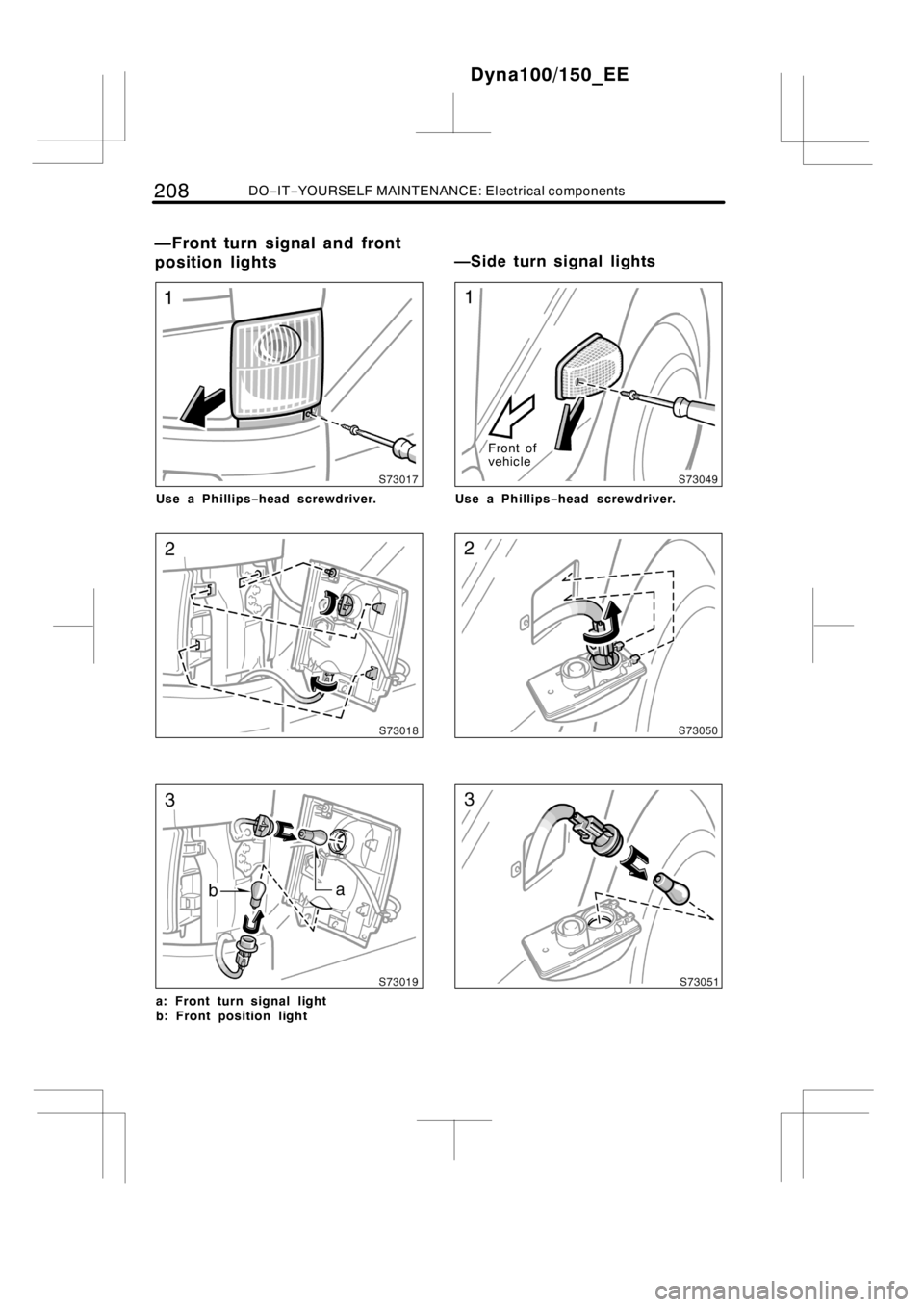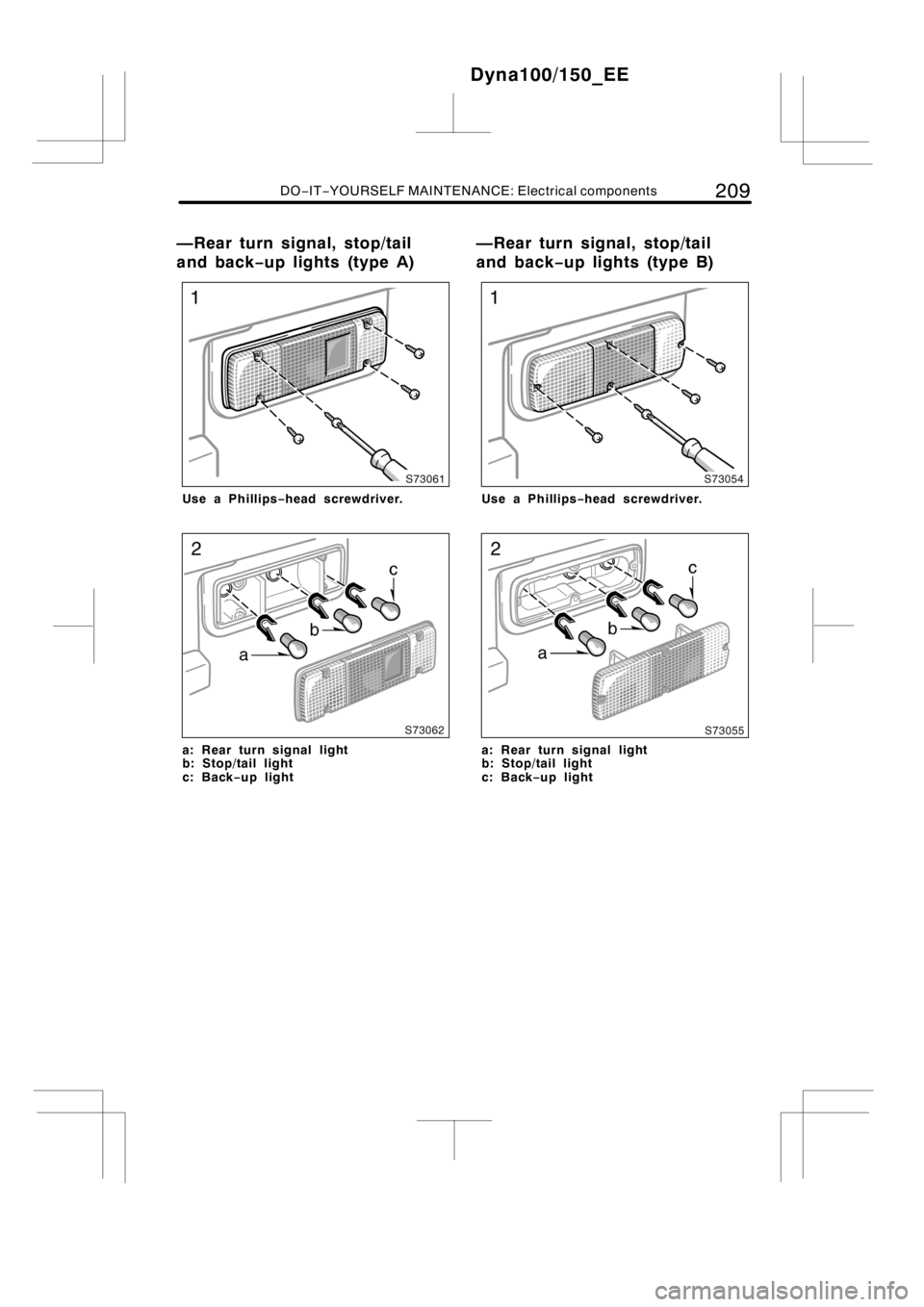2014 TOYOTA DYNA 100/150 turn signal
[x] Cancel search: turn signalPage 132 of 232

126STARTING AND DRIVING
After high−speed or extended driving that
requires a heavy engine load, the engine
should be allowed to idle, as shown in the
chart before turning it off.
Driving condition and required idling
time
Normal city driving
Idling time—Not necessary
High−speed driving
About 80 km/h (50 mph)
Idling time—About 20 seconds
About 100 km/h (62 mph)
Idling time—About 1 minute
Steep mountain slopes or continued
driving above 100 km/h (62 mph)
Idling time—About 2 minute
NOTICE
Do not turn the engine off immediate-
ly after a heavy load has been placed
on the engine in order to prevent en-
gine damage.
It is a good idea to do a safety check
before starting out on a trip. A few min-
utes of checking can help ensure safe and
pleasant driving. Just a basic familiarity
with your vehicle is required and a careful
eye! Or, if you would like, any authorized
Toyota dealer or repairer, or another duly
qualified and equipped professional, will
be pleased to make this check for you at
a nominal cost.
CAUTION
If you make this check in an enclosed
garage, make sure there is adequate
ventilation. Engine exhaust is poison-
ous.
BEFORE STARTING THE ENGINE
Outside the vehicle
Tires (spare included).Check the pres-
sure with a gauge and look carefully for
cuts, damage, or excessive wear.
Wheel nuts.Make sure no nuts are mis-
sing or loose.
Fluid leaks.After the vehicle has been
parked for a while, check underneath for
leaking fuel, oil, water, or fluid.
Lights.Make sure the headlights, stop
lights, tail lights, turn signals and other
lights are all working. Check the headlight
aim.
Battery and cables.All the battery cells
should be filled to theproper level with
distilled water. Look for corroded or loose
terminals and a cracked case. Check the
cables for good condition and connections.
Inside the vehicle
Jack and wheel nut wrench.Make sure
you have your jack and wheel nut wrench.
Seat belts.Check that the buckles lock
securely. Make sure the belts are not
worn or frayed.
Dyna100/150_EE
Precautions for turning off
an engine with turbochargerPre−trip safety check
Page 142 of 232

136STARTING AND DRIVING
TIRES
DEnsure that your vehicle’s tires are
properly inflated. See page 193 in Sec-
tion 7−2 and page 218 in Section 8 for
instructions.
DThe trailer tires should be inflated to
the pressure recommended by the trail-
er manufacturer in respect to the total
trailer weight.
TRAILER LIGHTS
DCheck for correct operation of the turn
signals and stop lights each time you
hitch up. Direct splicing may damage
your vehicle’s electrical system and
cause a malfunction of your lights.
BREAK−IN SCHEDULE
DToyota recommends that you do not
tow a trailer with a new vehicle or a
vehicle with any new power train com-
ponent (engine, transmission, differen-
tial, wheel bearing, etc.) for the first
800 km (500 miles) of driving.
MAINTENANCE
DIf you tow a trailer, your vehicle will
require more frequent maintenance due
to the additional load.
DRetighten all fixing bolts of the towing
ball and bracket after approximately
1000 km (600 miles) of trailer driving.
PRE−TOWING SAFETY CHECK
DBe sure not to exceed designated max-
imum load for the ball coupling of the
towing bracket. Please remember that
the ball coupling load will increase the
load on the vehicle. Maximum permissi-
ble rear axle capacity must not be ex-
ceeded.
DMake sure the trailer cargo is securely
loaded so that it cannot shift.
DIf the traffic behind the trailer cannot
be seen properly with the standard rear
view mirrors, additional outside mirrors
will be necessary. Both outside mirrors
must be fitted on folding arms and ad-
justed to give a good rear view at all
times.
TRAILER TOWING TIPS
Your vehicle will handle differently
when towing a trailer. In order to avoid
accident, death or serious injury, keep
the following in mind when towing:
DBefore starting out, check operation of
the lights and all vehicle−trailer connec-
tions. After driving a short distance,
stop and recheck the lights and con-
nections. Before actually towing a trail-
er, practice turning, stopping and back-
ing with a trailer in an area away from
traffic until you learn the feel.
DBecause stopping distance may be in-
creased, vehicle−to−vehicle distance
should be increased when towing a
trailer. For each 10 km/h (6 mph) of
speed, allow at least one vehicle and
trailer length between you and the ve-
hicle ahead. Avoid sudden braking as
you may skid, resulting in jackknifing
and loss of control. This is especially
true on wet or slippery surfaces.
DAvoid jerky starts or sudden accelera-
tion. Prevent excessive clutch slippage
by keeping engine rpm low and not
racing the engine. Always start out in
first gear.
DAvoid jerky steering and sharp turns.
The trailer could hit your vehicle in a
tight turn. Slow down before making a
turn to avoid the necessity of sudden
braking.
Dyna100/150_EE
Page 144 of 232

138STARTING AND DRIVING
CAUTION
DObserve the legal maximum speeds
for trailer towing.
DSlow down and downshift before
descending steep or long downhill
grades. Do not make sudden down-
shifts while descending steep or
long downhill grades.
DAvoid holding the brake pedal down
too long or too frequently. This
could cause the brakes to overheat
and result in reduced braking effi-
ciency.
Improving fuel economy is easy—just take
it easy. It will help make your vehicle last
longer, too. Here are some specific tips
on how to save money on both fuel and
repairs:
DKeep your tires inflated at the cor-
rect pressure.Underinflation causes
tire wear and wastes fuel. See page
193 in Section 7−2 for instructions.
DDo not carry unneeded weight in
your vehicle.Excess weight puts a
heavier load on the engine, causing
greater fuel consumption.
DAvoid lengthy warm−up idling.Once
the engine is running smoothly, begin
driving—but gently. Remember, howev-
er, that on cold winter days this may
take a little longer.
DAccelerate slowly and smoothly.
Avoid jackrabbit starts. Get into high
gear as quickly as possible.
DAvoid long engine idling.If you have
a long wait and you are not in traffic,
it is better to turn off the engine and
start again later.
DAvoid engine lugging or over−rev-
ving.Use a gear position suitable for
the road on which you are travelling.
DAvoid continuous speeding up and
slowing down.Stop−and−go driving
wastes fuel.
DAvoid unnecessary stopping and
braking.Maintain a steady pace. Try
to time the traffic signals so you only
need to stop as little as possible or
take advantage of through streets to
avoid traffic lights. Keep a proper dis-
tance from other vehicles to avoid sud-
den braking. This will also reduce wear
on your brakes.
DAvoid heavy traffic or traffic jams
whenever possible.
DDo not rest your foot on the clutch
or brake pedal.This causes premature
wear, overheating and poor fuel econo-
my.
Dyna100/150_EE
How to save fuel and make
your vehicle last longer
Page 211 of 232

DO−IT−YOURSELF MAINTENANCE: Electrical components205
The following illustrations show how to
gain access to the bulbs. When replacing
a bulb, make sure the engine switch and
light switch are off. Use bulbs with the
wattage ratings given in the table.
CAUTION
DTo prevent burning yourself, do not
replace the light bulbs while they
are hot.
DHalogen bulbs have pressurized gas
inside and require special handling.
They can burst or shatter if
scratched or dropped. Hold a bulb
only by its plastic or metal case.
Do not touch the glass part of a
bulb with bare hands.
NOTICE
Only use a bulb of the listed type.
The inside of the lens of exterior lights
such as headlights may temporarily fog up
when the lens becomes wet in the rain or
in a car wash. This is not a problem
because the fogging is caused by the
temperature difference between the outside
and inside of the lens, just like the
windshield fogs up in the rain. However, if
there is a large drop of water on the
inside of the lens, or if there is water
pooled inside the light, contact any
authorized Toyota dealer or repairer, or
another duly qualified and equipped
professional.Light bulbs
WTy p e
Headlights60/55A
Front position lights21/5B
Front turn signal lights21B
Side turn signal lights21B
Rear turn signal lights21B
Stop/tail lights21/5B
Back−up lights21B
Rear fog light21B
License plate lights10B
Interior light10C
A: H4 halogen bulbs
B: Single end bulbs
C: Double end bulbs
Dyna100/150_EE
Replacing light bulbs—
Page 214 of 232

208DO−IT−YOURSELF MAINTENANCE: Electrical components
Use a Phillips−head screwdriver.
a: Front turn signal light
b: Front position light
Front of
vehicle
Use a Phillips−head screwdriver.
Dyna100/150_EE
—Front turn signal and front
position lights
—Side turn signal lights
Page 215 of 232

DO−IT−YOURSELF MAINTENANCE: Electrical components209
Use a Phillips−head screwdriver.
a: Rear turn signal light
b: Stop/tail light
c: Back−up light
Use a Phillips−head screwdriver.
a: Rear turn signal light
b: Stop/tail light
c: Back−up light
Dyna100/150_EE
—Rear turn signal, stop/tail
and back−up lights (type A)—Rear turn signal, stop/tail
and back−up lights (type B)
Page 225 of 232

SPECIFICATIONS219
Instrument panel
Left side of the vehicle
Fuses (type A)
1. CIG 15 A:Cigarette lighter
2. DOOR 30 A:Power door locksystem
3. IG1−NO.2 10 A:Gauges and meters,
service reminder indicators and warning
buzzer, back−up lights, back buzzer
4. WIP 30 A: Windshield wipers and
washer
5. A/C 10 A:Air conditioningsystem
6.IG110A:Back−up lights, back buzzer
7. TRN 10 A:Turn signal lights, emergen-
cy flashers
8. ECU−IG 10 A:Anti−lock brake system9. RR−FOG 10 A:Rear fog light
10. OBD 10 A:On−board diagnosissystem
11 . D O M E 1 0 A :Interior lights
12. ECU−B10A:Headlights, tail lights
13. TAIL 15 A:Tail lights, front position
lights, license plate lights, instrument
panel lights, rear fog light
14. H−LP LL 10 A (vehicle with daytime
running light system):Left−hand
headlight (low beam)
15. H−LP RL 10 A (vehicle with daytime
running light system):Right−hand
headlight (low beam)
16. H−LP LH 10 A (vehicle with daytime
running light system) or H−LP LH 15
A (vehicle without daytime running
light system):Left−hand headlight
(high beam)
17. H−LP RH 10 A (vehicle with daytime
running light system) or H−LP RH 15
A (vehicle without daytime running
light system):Right−hand headlight
(high beam)
18. HORN 10 A:Horns
19. HAZ 10 A:Emergency flashers
20. STOP 10 A:Stop lights
21. ST 10 A:Starting system
22.IG210A:SRS airbag system
23.A/CNO.210A:Air conditioning sys-
tem
24. SPARE 10 A:Spare fuse
25. SPARE 15 A:Spare fuse
26. SPARE 20 A:Spare fuse
27. SPARE 30 A:Spare fuse
28. FOG 15A:Fog light
29. F/HTR 30 A:Front heater
30. EFI1 10 A:Engine control system
31. ALT−S10A:Charging system, charg-
ing system warning light
32.AM210A:Engine switch
Dyna100/150_EE
Fuses
Page 230 of 232

224INDEX
G
Gauge
Engine coolant temperature 68.........
Fuel 68...............................
Glove box 101...........................
Good driving practice 81.................
H
Hazard switch 64........................
Head restraints 27.......................
Headlight beam level control dial 63.......
Headlight switch 62......................
Heater idle up switch 93..................
High speed operation
During break−in 108...................
How to start the engine 124...............
I
Identification
Engine 122............................
Vehicle 120...........................
Ignition switch 80........................
Indicator symbols 8.....................
Instrument panel
Cigarette lighter and ashtrays 100......
Fuel gauge 68.........................
Indicator symbols 8....................
Odometer 70..........................
Tachometer 69........................
Trip meter 70..........................
Instrument panel overview 2,6...........
Intercooler
Checking the intercooler 192...........
J
Jack
Location 150..........................
Jump starting 143.......................
K
Keys 12,166............................
L
Light bulbs
Back−up lights 209....................
Front position lights 208................
Front turn signal lights 208.............
Headlights 206........................
License plate lights 210................
Rear fog light 210......................
Rear turn signal lights 209..............
Side turn signal lights 208..............
Stop/tail lights 209.....................
Light bulbs, Replacing 205...............
Light reminder buzzer 73.................
Light, Interior
Interior light 65........................
Limited slip differential 120...............
Lock
Side doors 13.........................
Side gate 16..........................
Steering column 80....................
Tailgate 16............................
Low brake fluid level warning light 73......
Low engine oil level warning light 73......
Low engine oil pressure
warning light 73.......................
Low fuel level warning light 73............
Low vacuum warning light 73.............
Luggage stowage precautions 119........
M
Maintenance
Do−it−yourself maintenance 185........
Does your vehicle need
repairing? 177.......................
Maintenance facts 176.................
Where to go for service 176............
Malfunction indicator lamp 73............
Manual regeneration switch,
Diesel particulate filter system 110......
Manual transmission
Driving with a manual
transmission 81.....................
Shift pattern 81........................
Maximum allowable speed
Manual transmission 81................
Mirrors
Folding rear view 59...................
Outside rear view 59...................
Dyna100/150_EE